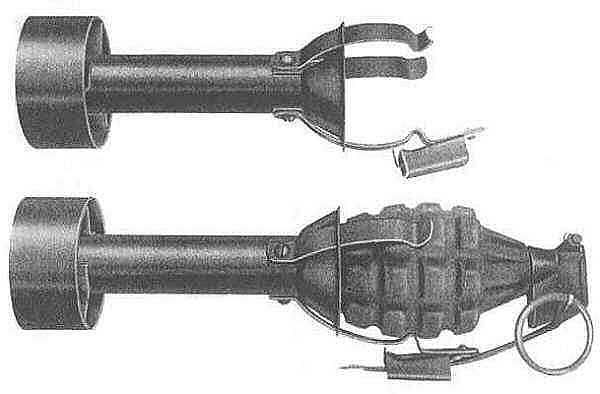The above photo shows a set of 3 claws, attached to a stabilizer tube and fins, into which a Mark II fragmentation grenade is inserted. Attached to one claw is a metal tab, which is inserted through an arming clip, then bent down to retain the clip to the claw. The grenade arming lever is inserted through the arming clip, and is restrained by the clip, keeping the grenade safetied even after the safety pin is removed
The launcher was an extension of your rifle. The rifle grenade, and hand grenade with adapter, were the projectiles fired.
First, the adapter/grenade was placed on the launcher to the desired range ring. Next, the grenade and adapter were rotated so the safety lever and arming clip were down. Then, the grenade was grasped firmly with one hand, and the pin withdrawn with the other.
With the frag grenade shown above, the arming-clip into which you insert the safety lever, or spoon, is kept on the adapter by the bent metal tab. When you fire it, inertia is enough for the arming clip to straighten out the bent piece, and this lets the adapter/grenade accelerate out of the clip, freeing the spoon, and arming the grenade.
The grenade stays attached to the adapter throughout the flight path, to the bitter end, with the flight stabilized by the tube and fins.
Times change, and so does weapon effectiveness. In general, we preferred regular Mark Deuce and Mark 14 hand grenades, with heavier duty stuff from the 60mm mortars. We didn't want tip our positions or make critical mistakes (like forgetting the grenade cartridge or forgetting to remove the launcher from the M1 - these things happen when a bunch of guys are coming at you in the dark). Remember, T-34 armor was invulnerable to the rifle anti-tank shaped-charge grenades. If we had to take on armor, we'd use 3.5 in. bazookas, or recoilless rifles, but we naturally preferred having the 105s or bigger arty, or our own tanks, knock them out. Against regular infantry, usually, we'd just shower ordinary hand grenades down on them, 30 yards or more, if they attacked us, and we would get to within 10 yards or so before throwing grenades, if we were going after them. Night patrols, when stuff hit the fan, all grenade action was at close quarters.
The rifle grenade was useful for 50-100 yard tries at crew served weapons in movement situations, or so I've heard at reunions.


